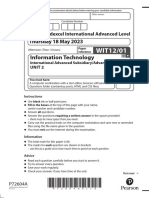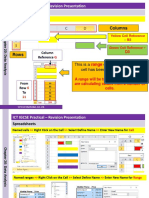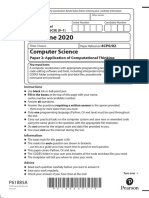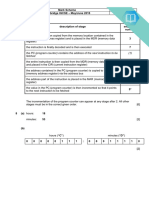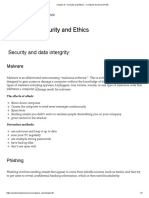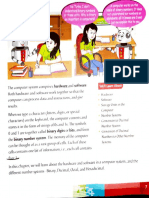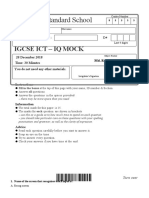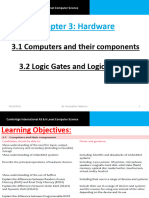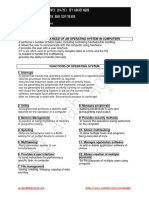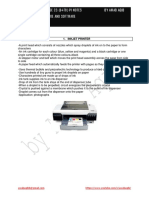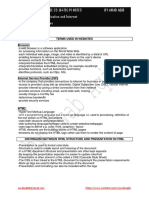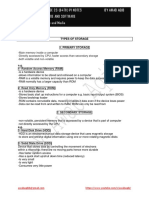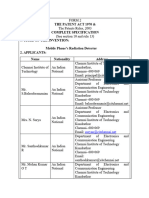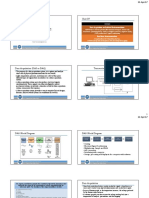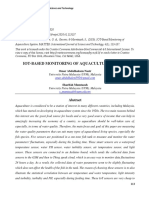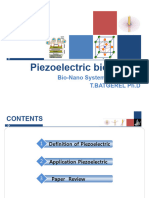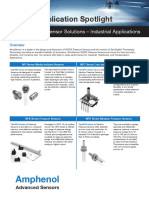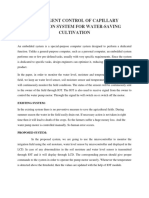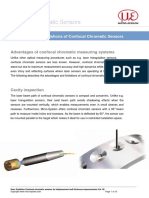GCSE CS (2210) / IGCSE CS (0478) P1 NOTES BY AWAB AQIB
CHAPTER 1.3: HARDWARE AND SOFTWARE
1.3.3 Input Devices
1. BARCODES
Linear Barcode with bars
2D Barcode - QR Quick response
Differences between a Bar Code and a QR Code
-Barcode is 1D and QR is code 2D
-Barcodes contain vertical lines and QR codes contain squares
-QR code can hold more data than a barcode
-QR code can be read from any angle
-QR codes are more error tolerant / faster to scan than barcodes
-Barcodes are frequently used at checkouts/ QR codes are used for advertising
-QR codes are frequently used by mobile phones to obtain information
What is a Barcode Reader
-Read labels containing parallel dark and light lines using laser light
-The width of each line represents a binary code
-Applications: automatic stock control
How is data read from a Linear Barcode
-Barcode is read by a red LED/laser from the Barcode reader
-Light is reflected by the dark areas of the barcode and bars are read
-Sensors read the reflected light
-As the bars are read, a pattern is generated and converted to digital form
-For example: the digit '3' on the left generates the pattern L D D D D L D (where L - light
and D - dark); this has the binary equivalent of O 1 1 1 1 0 1 (where L - O and D - 1)
awabaqibb@gmail.com https://www.youtube.com/c/awabaqib/
� GCSE CS (2210) / IGCSE CS (0478) P1 NOTES BY AWAB AQIB
CHAPTER 1.3: HARDWARE AND SOFTWARE
1.3.3 Input Devices
How is data read from a Quick Response Barcode
-Scanned using app on mobile device
-Camera is used to scan/capture the image
-The three large squares are used to define the alignment
-Black squares reflect less light / white squares reflect more light
-The app/device processes the image
-Each small square/pixel is converted to a binary value
Advantages of using a Quick Response Barcode
-There is no need for the user to write down or key in a website address; scanning the QR
code does this automatically
-QR codes can store website addresses URLs that appear in magazines, trains,
buses or even on business cards, giving a very effective method of advertising.
Use of Barcodes for automatic stock control / Point of Sale POS Terminal
-Barcode identifies a unique product
-Barcode can be used to look up product in a database
-Data about stock levels can be stored on a system
-Stock can be automatically deducted from the system
-Can check stock is below a certain level check stock level
-Automatic re-order/Alerts when stock is low
-Automatically update new stock level
-To locate if an item of stock is available in another location
Advantages of using Barcode to the management of a company
-Faster to update prices of the stock items
-Updated information on sale trends/patterns
-Supports automatic stock control
-Eradicates the need of labeling price on every item
-Possible to check customer buying habits more easily by linking barcodes to, for
example, customer loyalty cards
Advantages of using Barcode to the customer of a company
-Customers can get discounts since using barcode reduces operational costs
-Faster processing at checkouts/lesser wait time
-Given an itemized bill of their whole shopping for record
-Lesser chances of mischarging a price of an item
awabaqibb@gmail.com https://www.youtube.com/c/awabaqib/
� GCSE CS (2210) / IGCSE CS (0478) P1 NOTES BY AWAB AQIB
CHAPTER 1.3: HARDWARE AND SOFTWARE
1.3.3 Input Devices
2. TOUCH SCREEN
Benefits of using Touch Screen
-Easy to use interface
-Limited number of options
-Small space/space is limited
-Less chance for making an error in input
How does a Touch screen with Resistive touch detect your finger
-uses multiple layers of material that transmit electric currents
-when the top layer is pushed into the bottom layer
-electric current changes and location of touch is detected
Benefits of Resistive mobile touch screen
-Inexpensive/cheap to manufacture
-Can use stylus/finger/gloved finger/pen
Drawbacks of Resistive mobile touch screen
-Poor visibility in sunlight
-Vulnerable to scratching
-Wears through time
-Does not allow multi-touch facility
How does a Touch screen with Infrared touch detect your finger
-An invisible grid on the screen is there with patterns of infra-red LED beams
-Sensors detect the position of touch through a break in infra-red beams
-The position where the finger touched is calculated using this information
Benefits of Infrared mobile touch screen
-Good durability
-Allows multi-touch facility
-Can use stylus/gloved hands/pen
Drawbacks of Infrared mobile touch screen:
-Expensive to manufacture
-Screen glass will shatter/break/crack on impact
-Sensitive to dust/dirt
awabaqibb@gmail.com https://www.youtube.com/c/awabaqib/
� GCSE CS (2210) / IGCSE CS (0478) P1 NOTES BY AWAB AQIB
CHAPTER 1.3: HARDWARE AND SOFTWARE
1.3.3 Input Devices
How does a Touch screen with Capacitive touch detect your fingers
-Conductive layer
-An electrostatic/electric field is created
-Sensors around the screen monitor the electrostatic field
-When touched electrostatic charge is transferred to finger
-Location of touch is calculated / co-ordinates used to calculate touch
Why doesn’t touch screen work when we are wearing something on our hands
-Materials are an insulator
-Block current/charge from finger / body / person
-Stop the electrostatic field being disturbed/changed
How to make a touch screen work while wearing something on hands
-Use a conductive stylus, will allow the charge to be charged/disturbed
-Use capacitive gloves, this will allow the charge to be charged/disturbed
-Use voice operated interface, could give vocal commands to the device
Benefits of Capacitive mobile touch screen
-Good visibility in sunlight
-Durable surface
-Allows multi-touch facility
Drawbacks of Capacitive mobile touch screen
-Screen glass will shatter/break/crack on impact
-Cannot use while wearing any material on hands e.g. gloves
awabaqibb@gmail.com https://www.youtube.com/c/awabaqib/
� GCSE CS (2210) / IGCSE CS (0478) P1 NOTES BY AWAB AQIB
CHAPTER 1.3: HARDWARE AND SOFTWARE
1.3.3 Input Devices
3. INTERACTIVE WHITEBOARD / SMARTBOARD
-Allows a user to write on a surface
-Using a pen; text and drawings
-Are then captured electronically and stored for later use
-Allows to show images, videos on a whiteboard using a projector
-IWB can also be interacted with touch input, if it supports it
-Allows the whole audience to see the demonstration
-As all the applications can be used in real time and has internet support too
awabaqibb@gmail.com https://www.youtube.com/c/awabaqib/
� GCSE CS (2210) / IGCSE CS (0478) P1 NOTES BY AWAB AQIB
CHAPTER 1.3: HARDWARE AND SOFTWARE
1.3.3 Input Devices
4. MICROPHONES
-Audio device that allows audio signals from diaphragm to be converted into electric signals
-Which can be interpreted by a computer after being converted into digital by sound card
-Can be connected using USB port or wireless link
-Application: voice recognition, speech recognition
Voice Recognition:
-User’s voice from microphone is converted to digital signals
-Words are translated to wave patterns and computer compares it with already saved ones
-If the patterns match then it means they are from the same person
-Used in security systems e.g. unlocking phone by saying name
Speech Recognition:
-User’s voice from microphone is converted to digital signals
-Spoken words are recognized and shown on screen/input to an application e.g. Word
-If a person says: “Avengers Assemble!” / sound card converts it to digital form
-Software takes the digital form and decomposes it into phonemes
-Phonemes are smallest elements of language e.g. a b c
-Phonemes of “Avengers Assemble!” are compared with words in a pre-saved dictionary of a
language
-Based on the search, “Avengers Assemble!” would be found and written on the screen
-Quite a complex process/ needs to train computer on different dialects by different people
-Same process can be used to teach yourself a foreign language
-Allows people with disabilities to interact with the computer
awabaqibb@gmail.com https://www.youtube.com/c/awabaqib/
� GCSE CS (2210) / IGCSE CS (0478) P1 NOTES BY AWAB AQIB
CHAPTER 1.3: HARDWARE AND SOFTWARE
1.3.3 Input Devices
5. KEYBOARDS
-allows to interact with computer by pressing keystrokes
-used for business and personal purposes e.g. entering quantity of item, gaming
-can be connected using a USB port or wireless link
-each key on the keyboard has an ASCII value associated
-each keystroke is translated into a digital signal that computer understands
-can cause Repetitive Strain Injury (RSI) in wrists
-to deal with this, Ergonomic keyboards are use
-They have different arrangement of keys to provide comfort
Disadvantages of having user input his order through keyboard
-Prone to making mistakes
-Can be slow if not a regular keyboard user
-Dirt can get inside the keys and make keystrokes hard
6. SCANNERS
-Converts a hard copy document into an electronic form
-to be stored as a file on a computer
-Two types: 2D Scanner, 3D Scanner
2D Scanner
-Scanner shines a light onto the surface of a document
-Reflected light is captured
-Uses mirrors and lenses
-Captured image is converted into a digital file
-Produces a 2D digital image
-used to read passports and official documents at airports
awabaqibb@gmail.com https://www.youtube.com/c/awabaqib/
� GCSE CS (2210) / IGCSE CS (0478) P1 NOTES BY AWAB AQIB
CHAPTER 1.3: HARDWARE AND SOFTWARE
1.3.3 Input Devices
3D Scanner
-Scanner shines a laser over the surface of a 3D object
-Records measurements of the dimensions of the object
-Measurements are converted to digital file
-Produces a 3D digital model
-used to create 3d image of solid objects in Computed Tomographic (CT) scans
awabaqibb@gmail.com https://www.youtube.com/c/awabaqib/
� GCSE CS (2210) / IGCSE CS (0478) P1 NOTES BY AWAB AQIB
CHAPTER 1.3: HARDWARE AND SOFTWARE
1.3.3 Input Devices
Application on Airports to read Passports
-use Optical Character Recognition (OCR) technology to produce digital images
-images represent pages of passport
-OCR software can interact with images by extracting text and filling database fields
-photograph also scanned and saved as jpeg image
-passenger’s face is also photographed there and both are compared
-includes comparing distance between eyes, shape of jaw line/cheek bones
-process authenticates that both images represent the same passenger
7. DIGITAL CAMERAS
-Digital cameras don’t need a film to save photos like older cameras
-Save photos on a memory card and can be linked to computer via USB port or Bluetooth
Tasks carried out by Digital Camera
-Automatic focus
-Adjust the size and resolution of image
-Modify the aperture size
-Remove red eye effect upon the use of flash
How the images captured are converted to digital photo files
-Light passes through the camera lens onto a light-sensitive cell
-The cell is made up of millions of pixels
-Sensor measures the color and brightness of each pixel and stores it as a number
-Image is converted from analogue to digital using ADC
-Image is turned into pixels
-Each pixel is given a binary value
-Pixels form a grid to create the image
-Each pixel has a color
-Pixels are stored in sequence in a file
-Meta data is stored to describe the dimensions/resolution of the image
-Meta data stores the dimensions/color/ depth
-Saved in an image format e.g. JPG, PNG
awabaqibb@gmail.com https://www.youtube.com/c/awabaqib/
� GCSE CS (2210) / IGCSE CS (0478) P1 NOTES BY AWAB AQIB
CHAPTER 1.3: HARDWARE AND SOFTWARE
1.3.3 Input Devices
8. MOUSE
-Is a pointing device and perhaps the most commonly used input device
-Similar to keyboard, it can be connected through USB port or wireless link
-Traditional mice had a freely moving ball inside to detect the position of pointer on screen
-Latest mice use red laser to track the position
How does a Laser Mouse navigates the pointer on screen
-An LED at the back generates red light and shines it horizontally on the surface
-The light is from the LED hits the surface at a specific angle
-light-detector chip measures light reflected back up from the desk
-converting the analog movements of your hand into digital signals of X and Y coordinates
-Rotations of the scroll wheel can be detected using potentiometers
-similar to a volume knob on a speaker
-the rotations are converted to digital signals
9. TRACKERBALL
-Are seen more often in an industrial environment - such as a control room
-They don't need to move hence don’t need any desk space or special surface
-The operator is also less likely to suffer from injuries e.g. RSI
-A ball on the top of the trackerball is moved to control a cursor on the screen
-As with the mouse, buttons are used to select icons and to carry out functions
awabaqibb@gmail.com https://www.youtube.com/c/awabaqib/
� GCSE CS (2210) / IGCSE CS (0478) P1 NOTES BY AWAB AQIB
CHAPTER 1.3: HARDWARE AND SOFTWARE
1.3.3 Input Devices
9. SENSORS
-It is an input device
-It measures physical readings of the surrounding environment / physical properties
-Sensors are devices which read or measure physical properties
-These can include temperature, pressure, acidity and so on
-Real data is Analogue in nature – this means it is constantly changing and doesn't have a
discrete value
-Analogue data usually requires some form of interpretation
-However, computers cannot make any sense of these physical quantities and the data
needs to be converted into a digital format
-This is usually achieved by an Analogue to Digital Converter (ADC). This device converts
physical values into discrete digital values
-When the computer is used to control devices, such as a motor or a valve, it is
necessary to use a Digital to Analogue Converter (DAC) as these devices need analogue
data to operate in many cases
-An actuator is used in these control applications
-An actuator is an electromechanical output device such as a relay, solenoid or motor
List of sensors used in Process Control
Pressure sensor
-detect the pressure of an object
-detect intruders in alarm system, count vehicles moving over a bridge
pH sensor
-To measure how acidic/alkaline the soil is
-To alert when there may be something polluting the soil
Light sensor
-To measure the brightness of the environment
-To alert when the fruit has too little/too much light
-automatic switching on car’s headlights
Temperature sensor
-To measure the temperature of the environment
-To alert when it is too hot/too cold for the fruit to grow
-Central heating/air con system
Gas sensor
-To measure the amount of CO2/oxygen present
-To alert when too much CO2/oxygen present
-Pollution monitoring in a river
awabaqibb@gmail.com https://www.youtube.com/c/awabaqib/
� GCSE CS (2210) / IGCSE CS (0478) P1 NOTES BY AWAB AQIB
CHAPTER 1.3: HARDWARE AND SOFTWARE
1.3.3 Input Devices
Humidity/Moisture sensor
-To measure the water content in the air
-To alert when the air is too dry
Infra-red / motion sensor
-To measure level of infra-red/microwaves deflected
-To alert to any intruders e.g. animals stealing the fruit
-Automatic Doors
awabaqibb@gmail.com https://www.youtube.com/c/awabaqib/
� GCSE CS (2210) / IGCSE CS (0478) P1 NOTES BY AWAB AQIB
CHAPTER 1.3: HARDWARE AND SOFTWARE
1.3.3 Input Devices
awabaqibb@gmail.com https://www.youtube.com/c/awabaqib/
� GCSE CS (2210) / IGCSE CS (0478) P1 NOTES BY AWAB AQIB
CHAPTER 1.3: HARDWARE AND SOFTWARE
1.3.3 Input Devices
MONITORING SYSTEM USING SENSORS
How security systems use sensors and microprocessors to monitor a device
-Suitable sensor motion/infra-red
-Data converted from analogue to digital using ADC
-Data sent to microprocessor
-Data is compared to stored value/range
-If data matches/out of range data security device turned on
-Waits for suitable period/until no motion detected
-Device turned off
-Continuous loop/process
How temperature sensor and microprocessor control a constant temperature
-Analogue data / temperature is converted to digital data with an ADC
-Sensor sends signal to the microprocessor
-Microprocessor compares input values with stored values/pre-set values
-If the temperature value input is too high/low
-Signal is sent from the microprocessor to turn on / off / up / down the cooling unit
-An actuator is used to turn the cooling unit on / off / up / down
-If temperature matches the stored values, no action is taken
-The process is a continuous loop
How burglar alarm system (monitoring) works
awabaqibb@gmail.com https://www.youtube.com/c/awabaqib/
� GCSE CS (2210) / IGCSE CS (0478) P1 NOTES BY AWAB AQIB
CHAPTER 1.3: HARDWARE AND SOFTWARE
1.3.3 Input Devices
Monitoring vs Control System
awabaqibb@gmail.com https://www.youtube.com/c/awabaqib/











